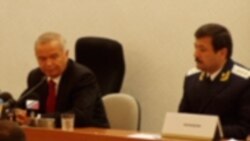Qodirov also said that rebels took more than 50 hostages during the violence, killing three women and two children, and that 32 government troops were killed.
Uzbek opposition members have said nearly 750 people were killed in the unrest. None of the figures could be independently confirmed.
Refugees Head To Kyrgyzstan
As the situation remains tense in eastern Uzbekistan, authorities in neighboring Kyrgyzstan are granting refugees asylum-seeker status and helping the wounded with medical treatment.
Hundreds of people have been congregating along the Uzbek border to cross into Kyrgyzstan since violence broke out in the eastern Uzbek city of Andijon on 13 May.
Reports that many refugees were killed while trying to reach border towns and villages could not be immediately confirmed.
Uzbekistan's opposition Ozod Dehqonlar (Free Peasants) party says the military shot and killed some 200 people in the vicinity of Pakhtaobod, a town located 35 kilometers from Andijon. Ozod Dehqonlar says it reached these figures by going house-to-house, asking residents if anyone in their families had been killed during the violence.
It seems that only a few of those trying to reach Kyrgyzstan were able to cross the border.
Carlos Zaccagnini, the chief of mission of the United Nations High Commissioner for Refugees (UNHCR), told RFE/RL's Kyrgyz Service in Jalal-Abad less than 600 Uzbeks were currently in a temporary refugee camp in Suzak, across the border from Pakhtaobod.
"We have information that 540 refugees are in Kyrgyz territory, and we have also confirmation that yesterday [16 May] the [Kyrgyz] Department of Migration had registered these persons as asylum seekers.," Zaccagnini said.
Addressing Kyrgyzstan's parliament today, Security Council Secretary Miroslav Niyazov said most refugees had crossed the border on 14 May from the Uzbek village of Teshiktosh. Niyazov said steps to handle the refugees were taken in coordination with the Uzbek government.
"We've been coordinating constantly since 14 May with the Uzbek side, at every level, the principles of our activities and our relations and how we should act in this or that situation," Niyazov said. "The cooperation has been at the highest level -- from talks between our border officials to talks between [interim Kyrgyz President] Kurmanbek Salievich [Bakiev] and Uzbekistan's top leadership."
The UNHCR believes most of these refugees fled Andijon while Uzbekistan's army and police were trying to reassert control over the city.
RFE/RL's Uzbek Service correspondent Elmurod Yusupaliev today went to the Suzak refugee camp, from where he filed this report: "Eighteen of [the 540 or so refugees] are wounded, or sick. Some of them have bullet wounds and there are sick children among them as well. These people are getting medical treatment at the hospital here in Suzak, Jalal-Abad region. All expenses are covered by the Kyrgyz government. The [Kyrgyz] Health Ministry delivers all medication for free. Among those 18 people [receiving medical treatment], three are under 18. They are not wounded, but they've been sick since they tried to leave Uzbekistan."
Yusupaliev said Kyrgyz border guards and local officials are distributing food and blankets among refugees.
Tight Access To City
Further south, in the divided town of Karasu/Kara-suu where riots broke out on 14 May, the situation is more confused.
News agencies today quoted a local rights activist as saying Karasu remained cordoned off by Uzbek troops. RFE/RL's Russian Service correspondent Andrei Babitskii, who returned from Karasu to Andijon last night, reports seeing troops and checkpoints all along the road.
Yet, whether government forces control the border that splits the town is unclear. Residents reportedly restored the bridge the Uzbek government had destroyed two years ago and are already trading goods with the town's Kyrgyz residents.
In Andijon itself, the situation remained calm today despite the overnight gunfire that broke out in army-sealed areas surrounding the regional administration's building.
Babitskii said residents were busy looking for relatives they feared might have been killed, or arrested. "Andijon residents do not know where to look for their relatives," he reported. "From every district, every street, people have disappeared. When we talk to people in the streets, more people come out from neighboring houses to tell us that a son, a brother, or two members of their family have disappeared. It does not necessarily mean that these people were killed. Some people have already learned that their relatives were arrested and are being held either at the regional police headquarters, or at the city police department. Be it as it may, people don't know what to think.
Except for the city center, which remains cordoned off by police forces, life is returning to normal in Andijon. Schools and shops have reopened. But Babitskii says he witnessed a few arrests while walking through the city.
Arrests
Uzbek authorities yesterday admitted to arresting 70 people on suspicion of either involvement in recent unrest, or ties with Islamic political groupings. But local human rights groups say the number of people detained in the past few days is much higher.
Rights groups also question the government's official death toll. They say more than 500 people were killed in Andijon on 13 May.
Uzbek Prosecutor-General Kadyrov said today that 169 people were killed during the suppression of the Andijon demonstration. This new figure contrasts with Tashkent's earlier toll of about 30 people killed.
Click here for a gallery of images from the violence in eastern Uzbekistan on 13-14 May.
See also:
What Really Happened On Bloody Friday?
Where Does Crisis Go From Here?
Protesters Charge Officials With Using Extremism Charges To Target Entrepreneurs
Analysis: Economic Concerns Primary In Andijon
Background: Banned Hizb ut-Tahrir Faces Dwindling Appeal, Internal Divisions
Interview: Opposition Leader Tells RFE/RL About 'Farmers' Revolution'

